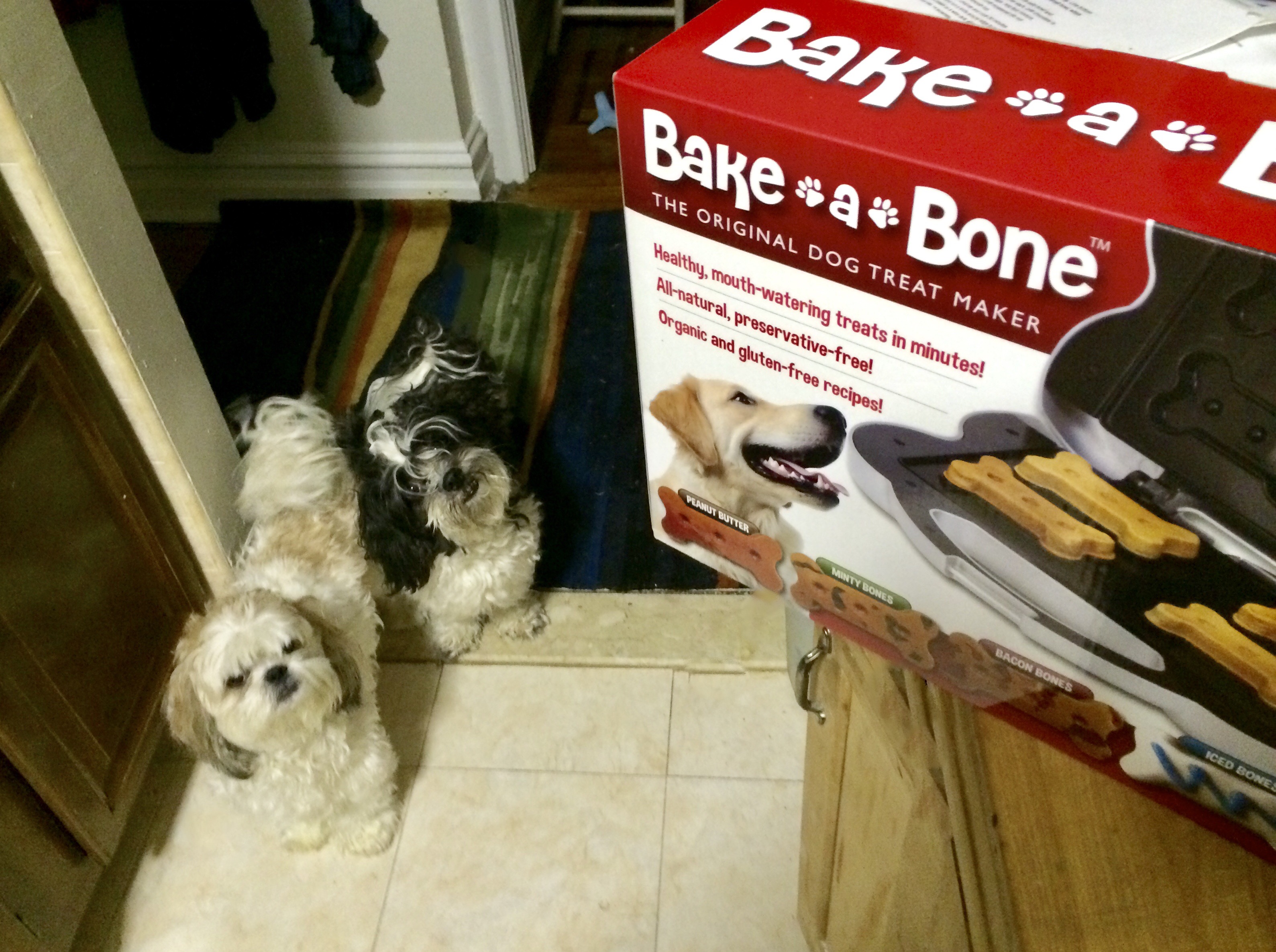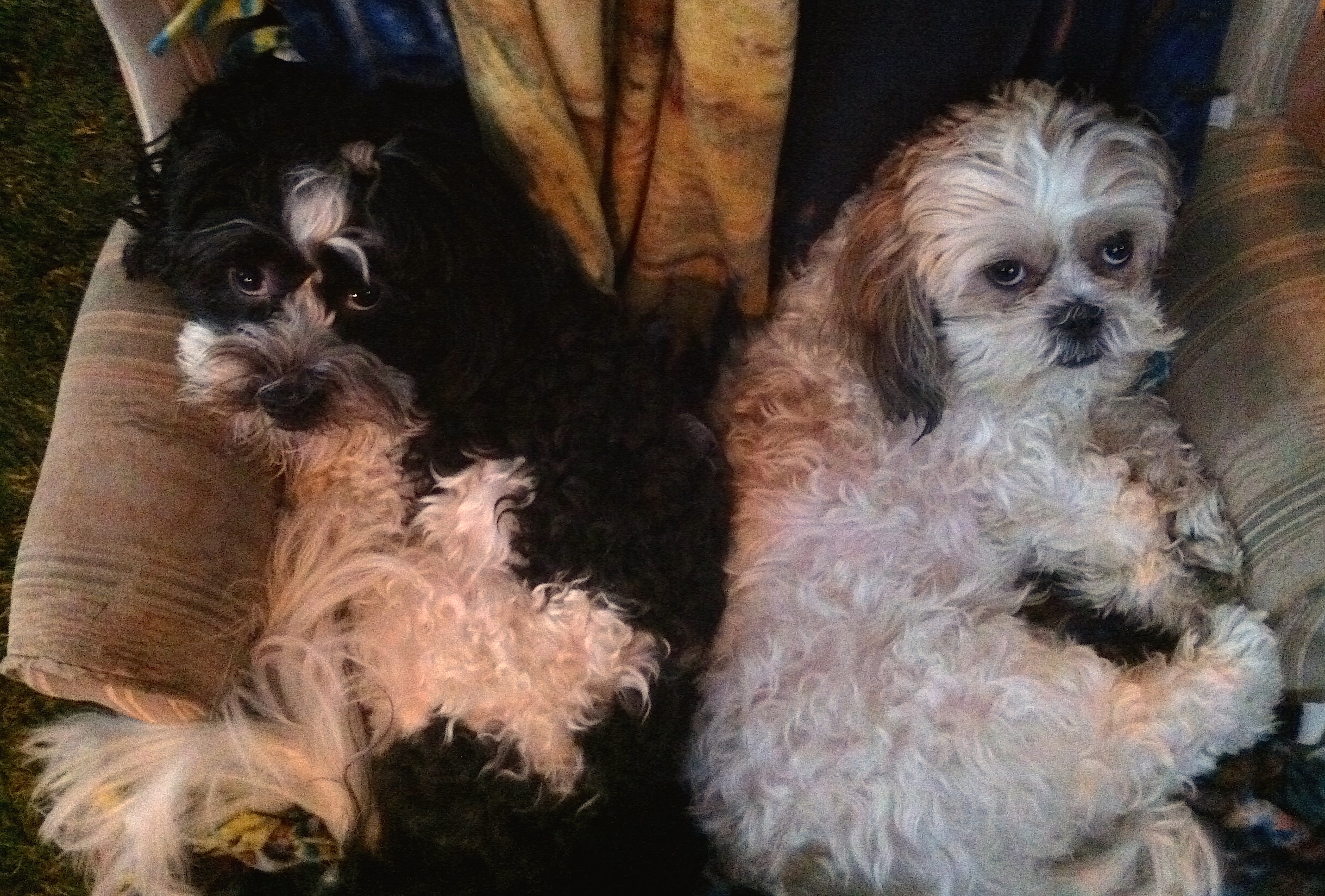That’s easy ~ do Clicker Training with your dog. Here I will give you step-by-step instructions~!

What is a ‘clicker’ and what is ‘Clicker Training’?
- A ‘clicker’ is a small device, usually disc shaped that fits into the palm of your hand. It has a button, usually in the center of it, and when you press the button it makes a distinct ‘click’ sound.
- ‘Clicker Training’ is a process in which you give your dog visual and vocal cues, and when your dog does the command, you click and give them a training-treat on every click sound.
This is what the clicker looks like, you can click on the picture for more information.
What will I need to do ‘Clicker Training’?
- A clicker. (LaZimnInc Dog Training Clicker with Wrist Strap – Pet Training Clicker, Big Button Clicker Set, 2-Pack(Blue + White)
- Training treats. Zuke’s worked best for us, tiny, healthy and yummy (Zuke’s Mini Naturals Healthy Moist Dog Training Treats 3 Flavor Variety Bundle 6 Oz. Ea). You can also make your own treats, see my recipe here for one kind, and then when they are hardened chop them up into little bits, place in a zip-lock bag and carry them with you during training and keep in the fridge when not using.
- A timer. Your Smart Phone will do.
- A noise-free quiet place to train.
How much time should I spend Clicker Training with my dog in a day?
This is a very good question. Dogs, especially puppies, can get mentally worn out very quickly. You only want to spend 15 minutes training an adult dog (hence the timer). Once your 15 minutes are up – give it a two or three hour rest. Don’t do it more than 3 times in a day, it’s too much for their little minds. For puppies, only do 10 minute increments.
Note: It’s very important to note two things about your furry love;
First, if they are just a puppy (under 1 year old) their little brains are still developing, like a child infant’s, and you can’t epect them to get it right all the time and always do exactly as you say. A lot of patience is needed during the puppy stage, but it can be very rewarding and have a big payoff if you do it correctly.
Second, always keep in mind the size of your furry love. For example, my dogs are 15 pounds each. I’m a much, much bigger person than them. When I give them a treat, I may think in my mind, “oh, that’s just a little treat” but the size of that little chew bone you gave them is actually the size of a regular hotdog sandwich for us. You have to keep their ratio size in account to the amount of treats you give them, which is why, ‘training treats’ are always the way to go, not larger treats.

These are the training treats we use. You can click on the photo for more information.
INSTRUCTIONS:
First the basics;
- Do not let your furry love see your bag of treats, otherwise, the focus will constantly be on that bag. It’s best to either keep a palm-full in your pocket, where you will pick one out at a time (when they are not looking) or in a zip-lock bag in a carry item. Try to grab the treat when your furry love is not looking, this takes the focus off the ‘treat location’.
- Sit with your furry love in a quiet environment, and show them the clicker, let them sniff it (as they do with all things). Start by just giving one click. Their little eyes and ears will perk up, at that moment they hear that click ~ give them 1 training treat. Wait now, until they get distract and are not looking at you (or smelling your pocket). Once they are distracted, click the clicker again. They will look, give them a treat. Only do this for your first training session. It will be the only time they will not have to ‘work’ for that treat.
- Important note: As you use the clicker you absolutely must always give them a treat when you click it. Even if you accidentally click the clicker, you must still give them a treat. This way they begin to understand they will always get a treat when they hear this sound.
- Throughout the day, have your bag of treats very close by. I kept them in my pocket because, during this part, you don’t want to click and then wait and go get the treat – that will defeat the purpose, keep your clicker and treats on you. As shown in the photo above, those clickers come with a wrist band, so you can literally have it around your wrist during your training period or through out a day you are hoping to catch them doing something good. If you happen to see your furry love do something right, for example, they go and pee on the wee-wee pad, (you have to actually see them doing this), as they are just finishing give them a ‘cue’ word and very quickly say; ‘wee-wee’, and a visual – point to the wee-wee pad and then say, “good boy/girl”, click the clicker, than give them a treat.
- During a new training session, lets say you want to train them to lay-down. Take a treat out. Let them sniff it and slowly back-up. This a ‘lure’ method and the dog will follow the scent. Place your hand with the treat low to the ground. Now with your free hand, point to them and then point to the ground, this is a visual cue (visual cues and verbal cues are very important in the training process), and give a cue word saying, “lay-down” at the same time. They might just stand there and try to sniff the treat out of your hand. Keep repeating the visual cue (pointing at them and pointing to the ground) while holding the treat to the ground and saying the cue word “lay-down”. The minute your furry love does this, click immediately and give them a treat. Now repeat this over and over no longer than 15 minutes. For the early training, stick with only this one learning pattern during one training session, it’s too overwhelming for them being taught one thing and then instantly changing to another. You will have to do this one training step over and over again before moving onto a new small step. Only after they have mastered some commands can your training sessions be varied.
- Important note: So, to re-cap, keep your treats hidden with you during the day and your clicker on your body to easily get to it. Watch to see if your dog does something during the day that is rewardable, say the word, click and give them a treat. You will use these steps for anything you want to train them to do. By giving visual cues (your finger pointing), and vocal cues, “come here”, clicking and rewarding you are giving them continual positive reinforcement as they learn the new behavior. Be patient, at first it will take them a while to figure it out, but once they figure it out, it will be very rewarding for both of you.
‘Sit’ training
- During a 15 minute training, get their attention, point to them (visual cue), and say, (vocal cue), “sit” and point downward with your finger as you say it. When they sit, click and give them a treat.
- Repeat this process, keep saying the cue word, “sit” and pointing your finger at them and then down to the ground as you say it. Remember that after they do it, you click, you give them the reward, you can also give positive reinforcement by saying, “good boy/girl” very enthusiastically.

‘Bathroom’ training
- I trained my dogs to use the wee-wee-pads. Most people want to train their dog to go outdoors. Keep in mind, dogs typically like to go to the bathroom during these times; 1) when they wake up in the AM, 2) when they have just finished breakfast, 3) when they just finished dinner, and just before they go to bed. During these times, start using a cue word like, “let’s go wee-wee”. If your dog has just eaten breakfast, give the cue word, “let’s go wee-wee” and take them outside. As they sniff around, the first few seconds you notice, just as they are about to do their business, and give the cue word “wee-wee~!” Just as they finish, click the clicker, and give them a treat. They will start to associate the cue word with going outside, going to the bathroom and getting a treat for it. All a win-win~!
- If your furry love does not go or does not get it right, do not scold, or berate them. Just ignore the bad behavior and continue to reward the good behavior.
- While doing this training, if you catch them going on a wee-wee pad or they do it first thing on command outside, give them a ‘jack-pot’ reward. Have a small canister with a bunch of training-treats in it and give it to them at once. But, try not to over-use the ‘jack-pot’ award – it should only be used as a special step where you didn’t have to repeat it or they did exceptionally well.
‘Stay’ training
- Hopefully you have taught your furry love, by now, how to sit. Have them sit and then say the cue word ‘stay’. Slowly back up, you can repeat the cue word ‘stay’ as you do it and I use the visual cue of pointing my finger at them directly as I back up. If your furry loves gets up and starts to come to you, take them back to the spot, have them sit and repeat.
- Once you get a good distance away, go back to them (you don’t want to be a distance away and say, “good boy/girl and click” they will come running and defeat the lesson of “stay”. Once you are close to them repeat the word ‘stay’, click, then give them the treat. You’ll want to keep repeating this, making the distance you step away longer and longer, you may even try going into another room and then coming back out to see if they are still in the same spot. If so, walk up to them, say, “good stay!”, click, and give them the reward.

‘Come here’ training
The command, ‘come here’ is very important to teach your furry love. There may be a time they get too far away from you and you need to command them to come back. For the training purpose make sure you can get a good distance from you dog but be in a safe environment, like a very large room, or fenced-in back yard.
- Give them the ‘sit’ and ‘stay’ command. Reward them when they do that with the clicker sound and treats.
- Back up a good distance and then give a visual cue, point your finger at them and then point it at your feet as you say the verbal cue ‘come here’. Keep repeating until your furry love comes to you, and the minute they come to you, click the clicker and give them their treat with lots of vocal ‘good boy/girl’.
Teaching fun tricks, like ‘roll-over’
- Have your dog do these tricks first, ‘sit’ (visual cue and vocal cue, click, give treat). Then, ‘lay-down’ (visual cue, vocal cue, click, give treat).
- Now that they are laying down, point your finger at them and do a rolling with the finger in a circular motion. Without hesitation, take the treat, put it by their nose, then move it slowly in a circular way over their head, they will be looking at it and most likely start to go into the position of rolling-over to follow it. Once they do the full roll-over, you can click and reward them. Repeat the cue word so they get to associate your finger roll, the word ‘roll-over’ with doing the action. Once they learn it, you will say, “roll-over” and twirl your finger, and they will roll over. Pending the ‘click’ and the ‘treat giving’.

Question: Once I’ve taught my dog the things I want him/her to learn, do I always have to use the clicker?
Great question. The answer is ‘no’. As time goes on, you give them the command, “roll-over”, visual ‘point finger at them and twirl it’, (and make sure this is well after they have learned the command) don’t use the clicker, just say, “Good boy/girl” and give them a training treat. Then the next day, try it again, always giving the visual cue (finger point) and vocal cue (‘sit down’) and then when they do it ~ “GOOD BOY/GIRL”, but this time, don’t give them a treat. Just pet them and give them a nice scratch under their chin. They will probably look at you like, “hey, where’s my treat?” but the positive tone of your voice and the quick pat, will eventually be enough – because – all dogs want to please their owners. It still doesn’t hurt, once in a while, to do the clicker as a brush-up training and/or to give training treats, just so they always remember there’s some type of reward.

This pretty much sums up the basics on clicker training. Once you and your furry love understand the ‘visual cue’, ‘vocal cue’, ‘click’ and then ‘giving them the treat’ – you can virtually teach them anything. Remember to keep training to only 15 minutes and no more than 3 times in one day. Good luck and let me know how your clicker training went~!
Please keep in mind that all dog tips should first be consulted with your vet to make sure they fit the needs and special instructions your furry love’s Dr. advises. Especially with food that you give them.
















